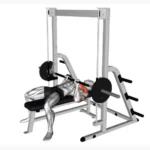One-Arm Dumbbell Bench Row: Exercise Overview
The one-arm dumbbell bench row is a variation of the traditional dumbbell row, performed with one hand supported on a bench for enhanced stability. This exercise targets the back muscles, promoting strength and growth in the lats, rhomboids, and traps. The back requires diverse training angles and techniques to maximize development.
Experimenting with different hand positions and bench angles can optimize muscle engagement and growth. Rows are a fundamental movement pattern, essential for balanced muscle development and strength. The bench-supported variation provides stability, making it an excellent choice for isolating the back muscles.
This exercise can be incorporated into back workouts, upper body sessions, pull-focused routines, or full-body training programs.
How to Perform the One-Arm Dumbbell Bench Row
- Place a dumbbell on the floor next to a flat bench. Stand on one side of the bench, holding the dumbbell in one hand with a neutral grip (palm facing inward).
- Position your free hand and knee on the bench for support, keeping your torso roughly parallel to the ground or slightly angled upward.
- Initiate the movement by driving your elbow backward, retracting your shoulder blade as you pull the dumbbell toward your hip until the elbow reaches or slightly passes your torso’s midline.
- Slowly lower the dumbbell back to the starting position under control.
- Complete the desired number of repetitions, then switch sides and repeat.
Tips for Optimal Performance
- Experiment with head positioning (looking forward or tucking the chin) to find what feels most comfortable and effective for you.
- Use the bench for support to maintain stability, avoiding the temptation to brace against your leg or twist your torso.
- Engage your core to prevent excessive spinal arching during the pull.
- Control the dumbbell throughout the entire range of motion, avoiding momentum to ensure proper muscle activation.
- If you feel your biceps overpowering the movement, try a false grip (not wrapping your thumb around the dumbbell) to emphasize back engagement.
- Avoid letting your head jut forward as you pull to maintain proper spinal alignment.
- Ensure the shoulder blade moves freely across the rib cage, rather than locking it down and relying solely on arm movement.
Strengthening your back with one-arm rows? Dive into our Ultimate Guide to Muscle Groups for back training.






